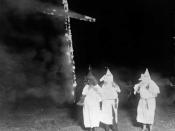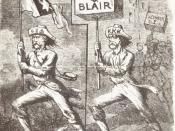In America, the 1920's were considered to be a 'roaring' time for all Americans. However, it seems to be that this 'roar' was an illusion for some Americans. This time was known as Americas 'age of excess'. In 1921, the gross national product was $74 billion, by 1229, it was $104.4 billion, but how much of this was affecting all Americans. Within this essay, I will be looking at different actions, which affected different people in different ways. For example: while the rich got richer, the poor made very little headway, with many families becoming poorer in the 1920's. By the end of the 1920's the number of people living below the poverty line (those who do not earn enough to buy food, clothing and basic shelter) had increased to an estimated 42 percent of the American population.
Many people through out America thought alcohol was harmful and dangerous and welcomed the introduction of prohibition.
In 1919, after the First World War, they got what they wanted. Congress (the American parliament) passed the 18th Amendment to the Constitution. The 18th Amendment stated...
"...after one year the manufacture, sale of, transporting of
intoxicating liquors for beverage purpose, the importing and
exporting of such liquors is hereby prohibited."
The Volstead Act, which was passed the same year, gave the federal governments the power to enforce prohibition, and then backed the 18th Amendment and from the 16th January 1920, the USA went "Dry". The people who opposed alcohol argued that it caused social problems such as violence, crime, poverty and sexual promiscuity. They believed that when it was banned, then America would be a better, healthier and a more moral place to live. There were many organisations, which led campaigns against alcohol. They included The Anti-Saloon League of America and The Women's Christian...


